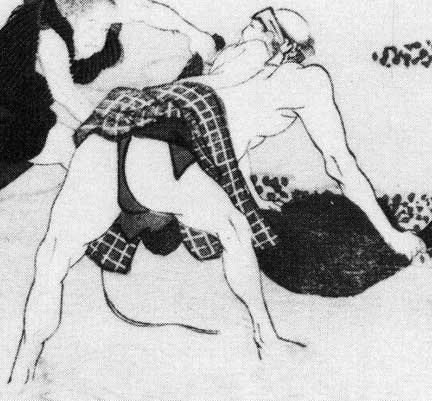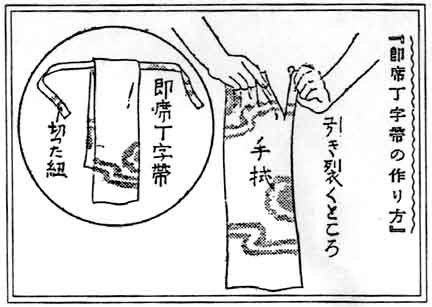|


|

Instructions for making Japanese washable
menstrual pads (early 20th
century?), successors of the uma (pony or horse)
In 1998 a Japanese college student,
Tomoko Maeno, kindly sent a copy of
her study of the history of Japanese
menstrual devices to this museum. Read
her English
version.
Below I reproduce two pictures from
"Reader on
Hygiene for Daughters, Wives, and
Mothers" about making
homemade pads, from her thesis;
they're from the early 20th century. Mrs. Akiko Roller
translated part of the text for this
museum.
Japanese women made their own
menstrual pads, tampons, sponges,
etc., before they were available
commercially, probably just like women
almost everywhere.
Ms. Maeno
points out in her own handwriting on
the document at the bottom of this page that she writes
about uma,
the
pony (or horse), in the grayed-out
columns.
Ms. Maeno did not
attach her references or
bibliography.
See ads for
Japanese commercial
belts
from the early 20th century, also
from Tomoko Maeno.
|
Below:
But before you
learn how to make menstrual gear
(underneath these images)
look at these
images of MEN
from 18th-19th century Japanese
woodblock prints that the artist Hokusai
drew (others engraved the wooden
plates just as the Frenchman Gustav
Dor� hired
others to engrave HIS famous wood
engravings). Hokusai broke ground in
Japanese art by
depicting ordinary
people.
|
Below: Japanese
laboring men wore a loin
cloth held by a
band around the waist (and
wore little else); this loin
cloth also seemed to serve
as underpants
under other clothing.
(Detail from one of the
prints of the series One
Hundred Views of Mt Fuji,
1834. No, those aren't
the twin peaks of Mt. Fuji;
Fuji has only one. As a kid
I walked to the top and slid
down its volcanic cinder
flows with my Explorer troop
when my family lived on
Okinawa, today the
southern-most part of Japan,
at that time an
American-governed
territory.)
|
Below:
Detail from Hokusai's Gathering
Shellfish, 1798.
Compare
with the menstrual gear,
below.
|

|

|
|
|

|
|

|
Below:
A part of Tomoko Maeno's thesis about
the history of Japanese menstrual
protection, part of which she sent to
MUM.
|
|
Mrs. Akiko Roller
translates the grayed area of the
thesis, below left, as follows:
"The actual examples of a T-shaped
sanitary belt appear in the book
called 'Reader
on Hygiene for Daughters, Wives, and
Mothers' [see the two
illustrations, above]. Three examples
of menstrual belts are shown. They
emphasize not only 'physiological
hygiene' but also user friendliness
and low cost, saying that they are
easy to use and wash, airy and
hygienic, and besides they are
economical because they only cost 0.78
Yen apiece to make.
"These types of
menstrual belts are not anything
special that the magazine 'Friend of
Housewives' invented, but were used by
ordinary people. They are probably
improved versions of a sanitary belt
called uma
(horse). The
uma is thought to be named after a
waistcoat or a belly band for horses
that prevented urine and feces from
soiling the environment, and they
have been in use since the Edo
Period (1603-1867)."
|
 |
 |
 |
|
� 2000 Harry Finley. It is illegal
to reproduce or distribute any of the
work on this Web site in any manner or
medium without written permission of
the author. Please report suspected
violations to [email protected]
|
|









